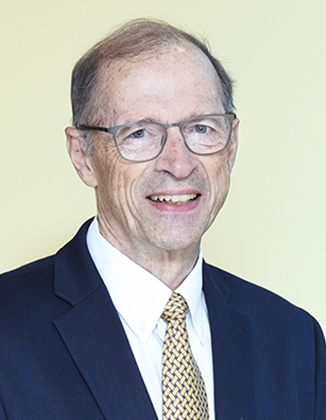George C. Schatz
Professor
Ph.D.: California Institute of Technology

- g-schatz@northwestern.edu
- Website
- 847-491-5657
- Ryan 4017
- Program Assistant: Mirjeta (Jeta) Remaley
Affiliations
Charles E. and Emma H. Morrison Professor of Chemistry and of Chemical and Biological Engineering
Chemistry of Life Processes Institute (CLP)
International Institute for Nanotechnology (IIN)
Trienens Institute for Sustainability and Energy
Research Statement
Our research involves theory and computation as applies to problems in nanotechnology, properties of materials, macromolecular structures and dynamics, molecular self-assembly, optics, plasma science, materials physics and biophysics. We are also interested in electronic structure methods, in quantum and classical theories of dynamical processes, in methods that combine electronic structure and electrodynamics, and in using these methods to study the reactions of molecules at interfaces.
A major interest is in the optical properties of metal nanoparticles and aggregates of nanoparticles, including applications in extinction and surface enhanced Raman spectroscopy, Rayleigh scattering and a variety of nonlinear optical properties, and in plasmon-driven photocatalysis. Much of our optical property work is concerned with classical electrodynamics, where we have developed new methods for describing light scattering and absorption, and methods for extending electrodynamics down to small structures. We are also learning to use electronic structure methods to describe nanoparticle optical properties, and in combining electronic structure theory and quantum electrodynamics.
We are actively studying the properties of nanostructured materials. Past work has considered plasmonic metal nanoparticle optical properties, and the structural and thermodynamics properties of particles that are linked by polymers such as DNA or peptides. The DNA and peptide work includes molecular dynamics studies, and the statistical mechanics of aggregate formation. A related interest is in the properties of arrays of plasmonic particles which exhibit lattice polariton modes. A recent activity has involved studies of photo-induced chemical reactions on the surface of plasmonic particles.
Another direction of interest is quantum science, as is concerned with the interaction of entangled photons with molecules, and in the properties of materials that make single photon emitters.
We are also involved in studies of aqueous interfaces that are used in ion uptake and transport experiments. This includes both electronic structure and molecular dynamics studies, with an emphasis on multiply charge metal cations interaction with transition metal dichalcogenide layers.
Another area of interest is chemical processes that take place under nonthermal conditions, including processes in the gas phase, at surfaces, and in liquids. Here we are performing electronic structure and molecular dynamics calculations to characterize the reactions of radicals, excited atoms and molecules with other atoms and molecules, to determine the reaction mechanisms under unusual conditions.
Selected Publications
Role of supramolecular polymers in photo-actuation of spiropyran hydrogels, Li, Chuang; Xiong, Qinsi; Clemons, Tristan D.; Sai, Hiroaki; Yang, Yang; Hussain Sangji, M.; Iscen, Aysenur; Palmer, Liam C.; Schatz, George C.; Stupp, Samuel I. Chemical Science 14(22), 6095-6104 (2023). DOI: 10.1039/d3sc00401e
Excited state nonadiabatic molecular dynamics of hot electron addition to water clusters in the ultrafast femtosecond regime, Leighton O. Jones, George C. Schatz, J. Phys. Chem. Lett. 14, 3521-26 (2023). DOI: 10.1021/acs.jpclett.3c00386
Chemomechanical modification of quantum emission in monolayer WSe2, M. Iqbal Utama, Hongfei Zeng, Tumpa Sadhukhan, Anushka Dasgupta, Sarah Gavin, Riddhi Ananth, Dmitry Lebedev, Wei Wang, Jia-Shiang Chen, Kenji Watanabe, Takashi Taniguchi, Tobin Marks, Xuedan Ma, Emily Weiss, George Schatz, Nathaniel Stern, and Mark Hersam, Nature Comm. 14, 2193 (2023). DOI: 10.1038/s41467-023-37892-0
Ethanol-induced condensation and decondensation in DNA-linked nanoparticles: a nucleosome-like model for the condensed state, Qinsi Xiong, One-Sun Lee, Chad A. Mirkin and George Schatz, J. Am. Chem. Soc. 145, 706-716 (2023) DOI: 10.1021/jacs.2c11834
Photodissociation of H2 on Ag and Au nanoparticles: effect of size and plasmon versus interband transitions of threshold intensities for dissociation, Sajal Kumar Giri, George C. Schatz, J. Phys. Chem. C, 127, 4115-4123 (2023). DOI: 10.1021/acs.jpcc.3c00006
Mechanical nanolattices printed using nanocluster-based photoresists, Qi Li, John Kulikowski, David Doan, Ottman A. Tertuliano, Charles J. Zeman IV, Melody M. Wang, George C. Schatz, X. Wendy Gu, Science 378, 768-773 (2022). DOI: 10.1126/science.abo6997
A Reaction Mechanism for Plasma Electrolysis of AgNO3 Forming Silver Nanoclusters and Nanoparticles, Astrid L. Raisanen, Chelsea M. Mueller, Subhajyoti Chaudhuri, George C. Schatz, Mark J. Kushner, J. Appl. Phys. 132, 203302 (2022) DOI: 10.1063/5.0127568
Polariton formation from Soret band excitons in metal-organic framesworks and plasmonic lattices, Alexander D. Sample, Jun Guan, Jingtian Hu, Francisco Freire-Fernandez, Sang-Min Park, Richard D. Schaller, George C. Schatz, Teri W. Odom, J. Phys. Chem. C 126, 18778-18783 (2022). DOI: 10.1021/acs.jpcc.2c05464
Manipulating two-photon absorption of molecules through efficient optimization of entangled light, Sajal K. Giri, George C. Schatz, J. Phys. Chem. Lett. 13, 10140 (2022). DOI: 10.1021/acs.jpclett.2c02842
An algorithmic approach based on data trees and genetic algorithms to understanding charged and neutral metal nanocluster growth, Chelsea M. Mueller, George C. Schatz, J. Phys. Chem. A, 126, 5864-72 (2022). DOI: 10.1021/acs.jpca.2c0464
Selected Honors/Awards
- Alfred P. Sloan Fellow, Dreyfus Fellow
- National Fresenius Award, Phi Lambda Upsilon
- Fellow, American Physical Society
- Fellow, American Association for the Advancement of Science
- Max Planck Research Award
- Editor-in-Chief, Journal of Physical Chemistry
- Fellow, International Academy of Quantum Molecular Science
- Fellow, American Academy of Arts and Sciences
- Member of the National Academy of Sciences
- Bourke Medal of the Faraday Division of the Royal Society of Chemistry
- Feynman Prize of the Foresight Institute
- Fellow of the American Chemical Society
- Peter Debye Award of the American Chemical Society
- S F Boys-A Rahman Award of the Royal Society of Chemistry
- Hirschfelder Prize, University of Wisconsin
- Irving Langmuir Award in Chemical Physics, American Chemical Society
- Ahmed Zewail Prize
- Materials Theory Award, Materials Research Society
- Marsha I. Lester Award for Extraordinary Impact in Physical Chemistry, American Chemical Society
